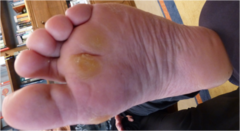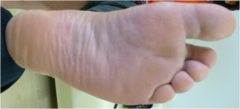Deformities - Injuries
Metatarsalgia
Metatarsalgia occurs in middle-aged women, sometimes along with hallux valgus. It is of unknown aetiology but is correlated with hormonal changes at menopause. The main complaint is pain on the plantar surface of the foot at the site of metatarsal heads’ protuberance. Callosities under the metatarsal heads is a common finding. Small toes may become curly, overlap or be like a hammer.
There are various insoles on the market that can provide alleviation of pain in early stages but substantial relief comes only with surgery. Many techniques have been described, all of them having in common combinations of tissue surgery, osteotomies, arthrodesis carried out with fine instruments and use of special plates, screws and pins.
General, spinal or regional anaesthesia can be used, the latter being is performed with some injections at the ankle joint.
Surgery for metatarsalgia is delicate and requires a lot of expertise. The patient is usually mobilized and discharged from hospital the first postoperative day. No use of special shoes is needed and return to preoperative activities is expected after some weeks. However swelling of the foot is not uncommon for a few weeks and sometimes some return of the deformity may be noted in the long run.
Apart from pain relief and cosmetic improvement the major advantage of these operations is the progressive disappearance of callosities in the months that follow surgery.

Προεγχειρητιτικά είναι εμφανείς οι πελματιαίοι τύλοι (κάλοι)

Μετεγχειρητικά οι τύλοι (κάλοι) έχουν εξαφανιστεί